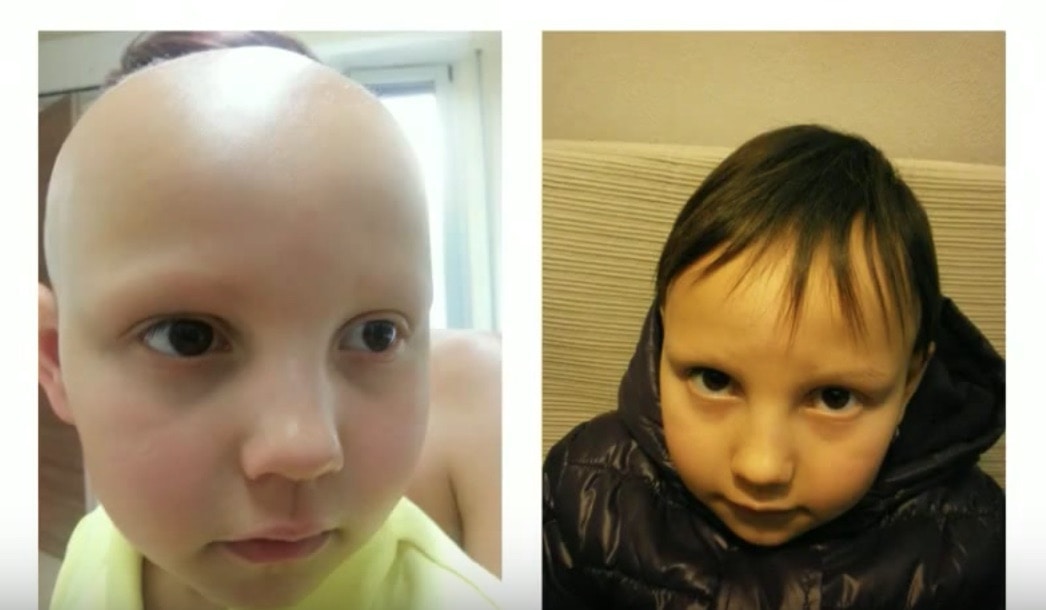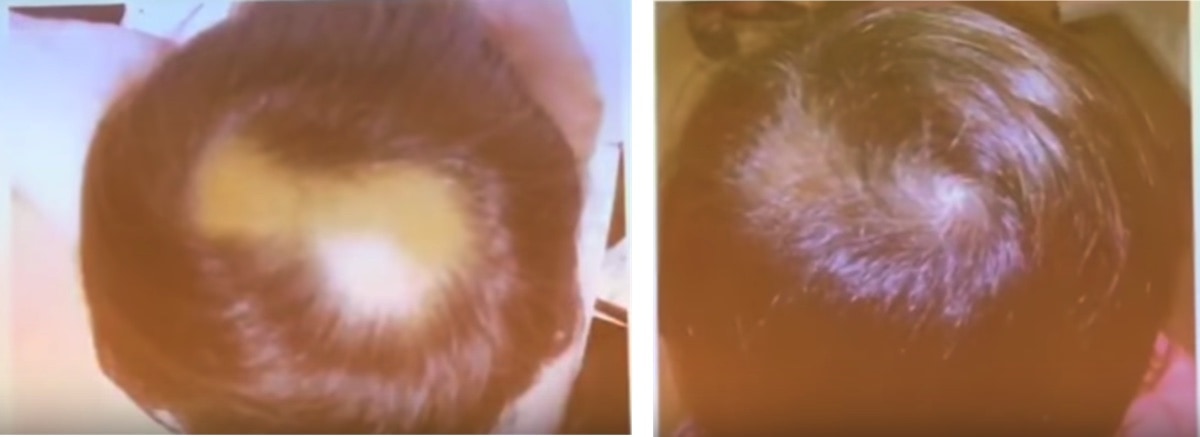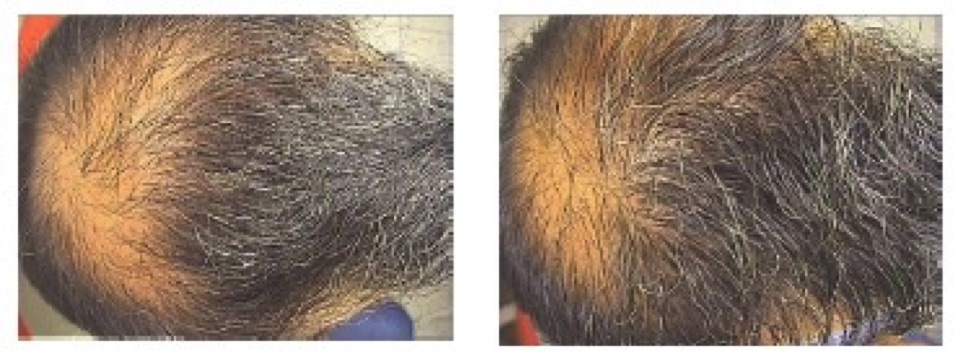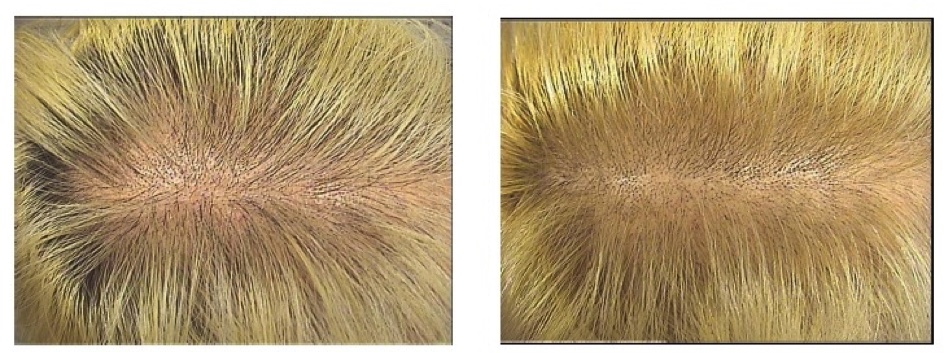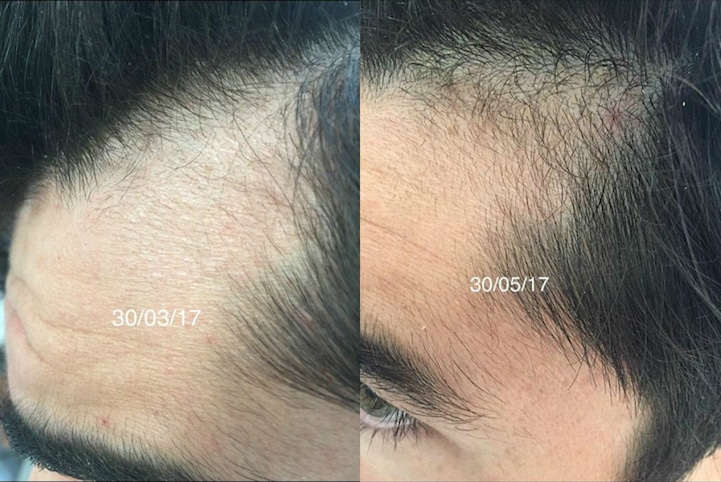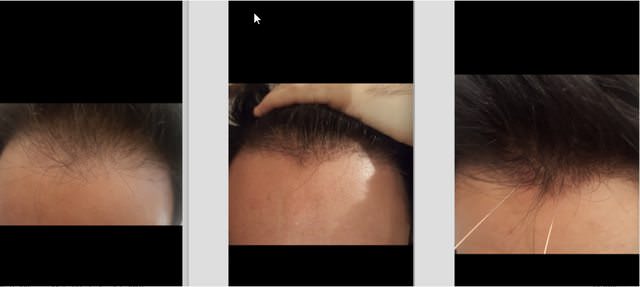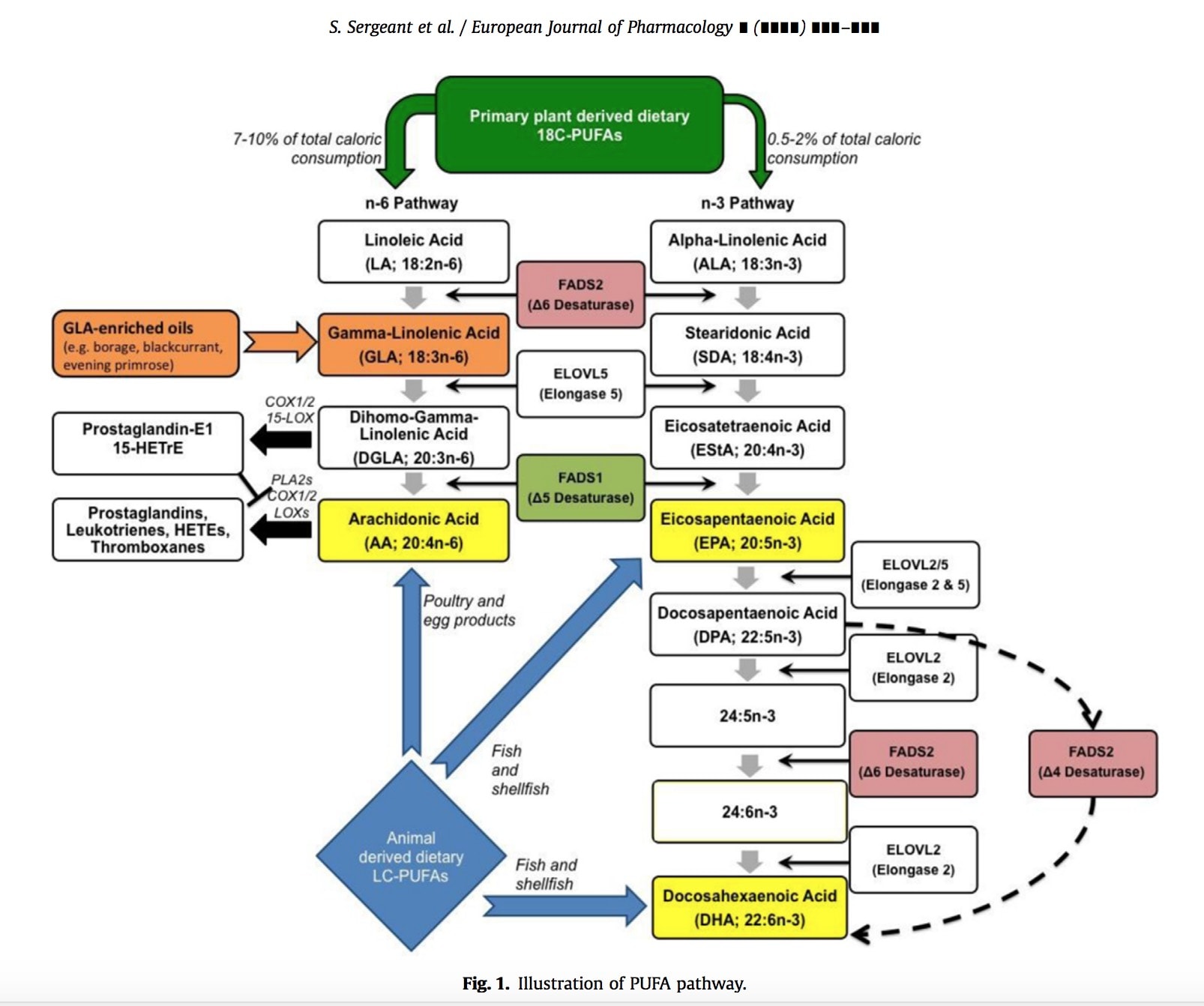- About
- Mission Statement
Education. Evidence. Regrowth.
- Education.
Prioritize knowledge. Make better choices.
- Evidence.
Sort good studies from the bad.
- Regrowth.
Get bigger hair gains.
Team MembersPhD's, resarchers, & consumer advocates.
- Rob English
Founder, researcher, & consumer advocate
- Research Team
Our team of PhD’s, researchers, & more
Editorial PolicyDiscover how we conduct our research.
ContactHave questions? Contact us.
Before-Afters- Transformation Photos
Our library of before-after photos.
- — Jenna, 31, U.S.A.
I have attached my before and afters of my progress since joining this group...
- — Tom, 30, U.K.
I’m convinced I’ve recovered to probably the hairline I had 3 years ago. Super stoked…
- — Rabih, 30’s, U.S.A.
My friends actually told me, “Your hairline improved. Your hair looks thicker...
- — RDB, 35, New York, U.S.A.
I also feel my hair has a different texture to it now…
- — Aayush, 20’s, Boston, MA
Firstly thank you for your work in this field. I am immensely grateful that...
- — Ben M., U.S.A
I just wanted to thank you for all your research, for introducing me to this method...
- — Raul, 50, Spain
To be honest I am having fun with all this and I still don’t know how much...
- — Lisa, 52, U.S.
I see a massive amount of regrowth that is all less than about 8 cm long...
Client Testimonials150+ member experiences.
Scroll Down
Popular Treatments- Treatments
Popular treatments. But do they work?
- Finasteride
- Oral
- Topical
- Dutasteride
- Oral
- Topical
- Mesotherapy
- Minoxidil
- Oral
- Topical
- Ketoconazole
- Shampoo
- Topical
- Low-Level Laser Therapy
- Therapy
- Microneedling
- Therapy
- Platelet-Rich Plasma Therapy (PRP)
- Therapy
- Scalp Massages
- Therapy
More
IngredientsTop-selling ingredients, quantified.
- Saw Palmetto
- Redensyl
- Melatonin
- Caffeine
- Biotin
- Rosemary Oil
- Lilac Stem Cells
- Hydrolyzed Wheat Protein
- Sodium Lauryl Sulfate
More
ProductsThe truth about hair loss "best sellers".
- Minoxidil Tablets
Xyon Health
- Finasteride
Strut Health
- Hair Growth Supplements
Happy Head
- REVITA Tablets for Hair Growth Support
DS Laboratories
- FoliGROWTH Ultimate Hair Neutraceutical
Advanced Trichology
- Enhance Hair Density Serum
Fully Vital
- Topical Finasteride and Minoxidil
Xyon Health
- HairOmega Foaming Hair Growth Serum
DrFormulas
- Bio-Cleansing Shampoo
Revivogen MD
more
Key MetricsStandardized rubrics to evaluate all treatments.
- Evidence Quality
Is this treatment well studied?
- Regrowth Potential
How much regrowth can you expect?
- Long-Term Viability
Is this treatment safe & sustainable?
Free Research- Free Resources
Apps, tools, guides, freebies, & more.
- Free CalculatorTopical Finasteride Calculator
- Free Interactive GuideInteractive Guide: What Causes Hair Loss?
- Free ResourceFree Guide: Standardized Scalp Massages
- Free Course7-Day Hair Loss Email Course
- Free DatabaseIngredients Database
- Free Interactive GuideInteractive Guide: Hair Loss Disorders
- Free DatabaseTreatment Guides
- Free Lab TestsProduct Lab Tests: Purity & Potency
- Free Video & Write-upEvidence Quality Masterclass
- Free Interactive GuideDermatology Appointment Guide
More
Articles100+ free articles.
-
Topical Minoxidil for Hair Growth: Efficacy, Safety, and How to Enhance Results
-
Oral Minoxidil for Hair Growth: Is it Effective and Safe? Our Analysis
-
Introducing Ulo: The Future of Hair Loss Telemedicine
-
OS-01 Hair Review: Does It Live Up to the Hype?
-
Stretching The Truth: 3 Misrepresented Claims From Hair Loss Studies
-
Minoxidil Shedding – What to Expect & When it Stops
-
Does Minoxidil Cause Skin Aging?
-
Thermus Thermophilus Extract Does Not Increase Hair Density By 96.88%, Despite Dermatology Times’ Claims.
PublicationsOur team’s peer-reviewed studies.
- Microneedling and Its Use in Hair Loss Disorders: A Systematic Review
- Use of Botulinum Toxin for Androgenic Alopecia: A Systematic Review
- Conflicting Reports Regarding the Histopathological Features of Androgenic Alopecia
- Self-Assessments of Standardized Scalp Massages for Androgenic Alopecia: Survey Results
- A Hypothetical Pathogenesis Model For Androgenic Alopecia:Clarifying The Dihydrotestosterone Paradox And Rate-Limiting Recovery Factors
Menu- AboutAbout
- Mission Statement
Education. Evidence. Regrowth.
- Team Members
PhD's, resarchers, & consumer advocates.
- Editorial Policy
Discover how we conduct our research.
- Contact
Have questions? Contact us.
- Before-Afters
Before-Afters- Transformation Photos
Our library of before-after photos.
- Client Testimonials
Read the experiences of members
Before-Afters/ Client Testimonials- Popular Treatments
-
ArticlesBrotzu Lotion For Hair Loss? Maybe, Maybe Not. (See Photos)
First Published May 24 2018Last Updated Oct 29 2024Company ReviewsIngredientsPharmaceuticalResearched & Written By:Perfect Hair Health TeamReviewed By:Rob English, Medical EditorWant help with your hair regrowth journey?
Get personalized support, product recommendations, video calls, and more from our researchers, trichologists, and PhD's dedicated to getting you the best possible outcomes.
Learn MoreArticle Summary
In 2016, Brotzu Lotion made headlines as a potential hair loss cure. But does this topical actually live up to its hype? Yes and no. On the positives, Brotzu Lotion (now branded as Trinov™) might stop the progression of pattern hair loss. It can also improve alopecia areata. But is it better than minoxidil or finasteride? The evidence is mixed.
Full Article
In 2016, an Italian surgeon made hair loss headlines after announcing the accidental discovery of a topical formula that showed promise in slowing, stopping, and even reversing hair loss. Its name? Brotzu Lotion — titled after the creator himself: then-81-year old Giovanni Brotzu.
What happened next is what always happens: hair loss forums went wild.
Hair loss sufferers began researching the ingredients in Brotzu Lotion’s patent. They organized group buys to source, compound, and self-distribute crude versions of the lotion ahead of Brotzu’s expected 2018 release.
Some hair loss sufferers even contacted Dr. Brotzu himself — who, in correspondence, suggested that the lotion could turn back the balding clock by 5 years… and that there are no reported side effects.
Nearly two years later, where do we stand?
Since then, excitement for Brotzu Lotion has fizzled, returned, died, and just recently… exploded. The question is: will Brotzu Lotion — set for a 2018 release in Europe — actually live up to the hype?
I’m cautiously optimistic, with caveats. Emphasis on caution and caveats. This article explains why.
We’ll uncover the science behind Brotzu Lotion — its ingredients, mechanisms of action, and 120-day study results. Then we’ll dive into Brotzu’s before-after hair regrowth photos — along with some photos people claim are from Brotzu Lotion, but really aren’t.
Finally, we’ll reveal which kinds of hair loss the lotion may help — pattern hair loss (androgenic alopecia) or autoimmune-related hair loss (alopecia areata and alopecia universalis) — and if you’re planning on trying Brotzu Lotion, where to set your hair regrowth expectations.
Brotzu Lotion: A Hair Loss Breakthrough… Or All Hype?
Brotzu Lotion is a topically-applied hair loss lotion expected to arrive in Europe in late-2018.
At first glance, this is no big deal. After all, there are dozens of lotions used to combat hair loss — from FDA-approved drugs like minoxidil (Rogaine) to less conventional topicals like emu oil, rosemary oil, or even topical finasteride (Propecia). So what makes Brotzu Lotion worth any attention?
Three things.
Firstly, its inventor claims that for most users, Brotzu should reverse balding by five years within 18 months of use. That’s a huge claim in the hair loss world — one not even Propecia makes.
Secondly, a few great before-after hair regrowth photos are already circulating online — spurring excitement for many hair loss sufferers.
Thirdly, its ingredients and the way the lotion works (its mechanisms of action) are novel — meaning we’ve yet to see a topical target hair loss this way before (at least one that’s made it to market).
Let’s take these one-by-one.
Who Is Giovanni Brotzu — The Inventor Of Brotzu Lotion?
Whenever we hear of a new hair loss treatment, we should look at the person behind the discovery. Are they reputable? Are they operating under a pseudonym? Are they actually just a marketer? Or are they a scientist, working alongside a research team, with published literature to back up their claims?
Oftentimes, this all we need to determine if a new hair loss “breakthrough” is all-hype or the real deal. And encouragingly, in this case, Brotzu Lotion’s inventor (Giovanni Brotzu) is no quack.
Dr. Brotzu is a retired vascular surgeon. He’s the holder of several provisional patents for surgical implants, and his late father — a pharmacologist — was once a candidate for the Nobel Prize.
So how does one go from vascular surgeon to hair loss lotion creator? According to Brotzu, by accident.
Dr. Brotzu’s team was trialing a drug to treat a complication of diabetes: vascular insufficiency in the legs (which can lead to limb loss). When they saw the drug improved vascularity and hair growth on subjects’ legs, they reformulated it into a topical — and tested it on a nurse with hair loss on her scalp.
The results were impressive enough for Dr. Brotzu to pilot more case studies and then create a patent around the formula… which grabbed the attention of the Fidia Pharma Group — a pharmaceutical company. That’s when Brotzu Lotion picked up attention on hair loss forums… and when people started asking for photo evidence.
They didn’t have to wait long. Within the year, photos started circulating — along with study results.
Brotzu Lotion — Early Results (Hair Regrowth Photos)
So far, Brotzu Lotion has been studied on two types of hair loss: autoimmune hair loss (like alopecia areata and alopecia universalis) and pattern hair loss (also known as androgenic alopecia).
Results: Brotzu Lotion For Autoimmune Hair Loss (Case Studies)
Initial case studies (i.e., single-person tests) with Brotzu Lotion show promise for an autoimmune condition called alopecia areatea. This is when a person loses hair, usually in patches, anywhere on the scalp (the sides, tops, and backs of the head — and even the eyebrows). In advanced stages, this leads to hair loss everywhere on the body (alopecia universalis).
In a 2016 presentation, Dr. Brotzu showcased Brotzu Lotion’s one-year hair regrowth results for a female child suffering from alopecia universalis. Here are her before-after photos:
That’s significant hair recovery — and for those with alopecia areata / universalis — incredible results.
Encouragingly, Dr. Brotzu’s patent cites more case studies (but no photos) and claims improvement for pretty much all of his subjects with autoimmune-related hair loss. In fact, he even presented more before-after photos of autoimmune hair loss subjects (here’s the link — start at 10:30) at another conference. The takeaway? Similar results. See this screenshot:
Another near-full recovery from alopecia areata — and in 16 months.
What’s yet-to-be determined: how much hair regrowth alopecia areata / universalis sufferers can expect. So far, it looks like full recoveries are within the realm of possibilities.
But is the same true for pattern hair loss — a much more common type of hair loss? Can androgenic alopecia sufferers expect similar recoveries — or even to shave five years off the “balding clock”?
Unfortunately — at least so far — the data suggests probably not.
Brotzu Lotion For Pattern Hair Loss (A Clinical Study)
In April 2018, Dr. Brotzu presented preliminary study results of Brotzu Lotion for pattern hair loss.
As with any study, its design matters. So here’s a quick overview of the study design…
- Subjects: 30 males, 30 females — all with androgenic alopecia
- Treatment: 1mg of Brotzu Lotion, applied daily in balding regions
- Duration: six months — with follow-ups at months 0, 1, 3, and 6
…And here’s what the team measured at each follow-up session:
- Scalp exam — to check for skin quality changes (i.e., side effects)
- Hair diameter — a surrogate for hair thickness
- Photographic analysis — to measure the total number of hairs, the percent of anagen hairs (hairs in their growth phase), and the percent of telogen hairs (hairs in their resting phase)
(Note: the investigators also measured hair fall during wash tests and tug tests. But for androgenic alopecia — these metrics are basically useless, so we won’t cover them).
Brotzu Lotion’s Six-Month Results For Androgenic Alopecia (And Photos)
After six months, here were the study’s findings:
- Scalp exam — no changes (no side effects)
- Hair diameter — no significant changes
- Photographic analysis — an increase in anagen hairs (growth phase), a decrease in telogen hairs (resting phase), and no mention of the overall change in hair count
The two major takeaways are that 1) hair thickness did not change, and 2) while the ratio of hairs in the growth vs. resting phase improved, we still don’t know about the overall change in hair count (unless I missed it somewhere — which is possible, since the presentation was in Italian).
So how do these results translate into photographs?
Here are two subjects Dr. Brotzu highlighted in his presentation. First, a before-after photo of a male:
Next, a before-after photo of a female:
The takeaways? Very little regrowth for the male, and maybe slightly more regrowth for the female — though it’s hard to say. It seems like the female got her roots colored between photos, and in the “after” photo, her dyed blonde hair may just blend better into the scalp skin.
What Should We Make Of Brotzu’s Results For Pattern Hair Loss?
I’m not impressed, but I’m also not surprised.
When it comes to pattern hair loss, it’s hard to find a good treatment. In fact, most topicals / supplements on-the-market for androgenic alopecia (pattern hair loss) are either completely ineffective, or only demonstrate hair regrowth on paper (in a study) — with any marginal changes in hair count rarely translating to photos.
Long-story short: the above results are, sadly, ones we’ve come to expect for pattern hair loss.
But how is that possible? After all, people suffering from autoimmune-related hair loss showed major hair recoveries using Brotzu Lotion. Why aren’t we seeing the same results for pattern hair loss?
Well, autoimmune hair loss is not pattern hair loss. They’re entirely different conditions. And unfortunately, hair loss forums confuse the two all the time.
Autoimmune Hair Loss Is Not Pattern Hair Loss
Autoimmune hair loss presents as patchy hair loss anywhere on the scalp. Pattern hair loss presents as a receding hairline, a bald spot, or general “diffuse” thinning above the sides of the scalp.
Autoimmune hair loss is when the body confuses its own hair follicles as foreign invaders. Pattern hair loss is the result of an interplay between genetics, hormones, and skin remodeling (fibrosis).
Autoimmune hair loss accounts for less than 5% of hair loss cases. But pattern hair loss? 95% of cases.
While both conditions are linked to inflammation, but only pattern hair loss leads to scarring. And while both conditions result in hair loss, their pathologies — and thereby treatments — vary wildly.
The bottom line: we should never assume treatments for alopecia areata will translate to androgenic alopecia (pattern hair loss). It’s making an apples-to-oranges comparison.
So… Should We Dismiss Brotzu Lotion For Pattern Hair Loss Entirely? No
Firstly, we need to keep in mind that hair loss treatments take a long time to work.
For reference, studies show that finasteride (Propecia) takes two years before reaching full efficacy. Minoxidil (Rogaine) takes 6-12 months. And Dr. Brotzu himself said that the lotion needs 18 months for the full effect.
Brotzu Lotion’s study was only six months long. Maybe a six-month study wasn’t long enough to see significant results. We won’t know until Fidia Pharma releases more data.
Secondly, the Brotzu family continues to release more androgenic alopecia before-after photos… and some of these photos do show significant hair recovery.
In fact, following backlash in one hair loss forum, Dr. Brotzu’s son registered a username (and chimed in) to defend his father’s lotion — and with a new case study. His response, translated: “Statistics are used in medical congresses, photos are used in advertising.”
He then shared photos of a better responder — a male using Brotzu Lotion for two months…
…and to me, these results are significant, and worth sharing. Which makes me wonder why Dr. Brotzu didn’t share more photos like this during his presentation.
Brotzu Lotion: Key Takeaways From Study Results (So Far)
In any case, we have enough information to draw a few conclusions:
- Brotzu Lotion, on average, may work well for autoimmune-related hair loss
- Brotzu Lotion, on average, may only marginally improve pattern hair loss in six months
- Brotzu Lotion, for a small percentage of pattern hair loss sufferers, may work amazingly
And while I have reservations about Brotzu Lotion reversing our baldness “clock” by five years, I also find the lotion’s mechanisms of action to be novel, fascinating, and a step in the right direction for hair loss treatments.
In fact, the way the lotion works is almost like minoxidil (Rogaine) meets a topical finasteride (Propecia) — but through different mechanisms, and without the side effects (so far).
And to understand how, we need to understand Brotzu Lotion’s ingredients. [Note: the following section gets a bit technical, and if you’re not interested, there’s a summary of everything at the bottom of this article.]
Brotzu Lotion’s Ingredients
According to its patent, Brotzu Lotion primarily consists of three ingredients:
- Propionyl-L-Carnitine — an amino acid (protein)
- S-Equol — a non-steroidal estrogen derived from soy
- Dihomo-Gamma-Linoleic Acid (DGLA) — an omega six fatty acid
This is already a bit of a mouthful. So let’s break down each ingredient, rationalize why they’re included, and explain how all of them — when combined — may be synergistic for our hair.
How Brotzu Lotion’s Ingredients May Help Regrow Hair
Ingredient #1: Propionyl-L-Carnitine
When it comes to any hair loss topical — whether it’s minoxidil (Rogaine) or rosemary essential oil — penetration and metabolism of the “active ingredients” are key to a topical’s success.
For instance, if a hair loss topical ingredient helps regrow hair, but its ingredients can’t penetrate the top layer of our scalp skin, it’s useless. It won’t reach all the way down to our hair follicle dermal papilla cells — the place the ingredients must reach in order for the lotion to work.
And if that same ingredient penetrates our scalp skin, but it can’t be metabolized (absorbed) by our hair follicle cells, then it’s still useless. We need our scalp tissues to absorb (and use) those ingredients. Otherwise, they’ll just sit there indefinitely.
In the topical world, there’s a name for substances that help with penetration and/or metabolism: carriers. For example, minoxidil’s carrier (among many) is a substance known as propylene glycol. It helps minoxidil penetrate and absorb into the skin, which is why manufacturers add it to minoxidil to manufacture Rogaine.
Brotzu Lotion’s equivalent to a “carrier” is an ingredient called propionyl-l-carnitine.
Propionyl-l-carnitine is a protein. It’s also a derivative of l-carnitine. It’s associated with antioxidant activity and, importantly, the improved transportation of fatty acids to cells…
…which is exactly why it’s used in Dr. Brotzu’s formula. Propionyl-l-carnitine increases the metabolism of a certain fatty acid ingredient (keep reading), and it also improves the metabolism of its two main ingredients.
So what are Brotzu Lotions main ingredients? A plant-derived compound that helps reduce DHT, and a fat-derived substance that improves blood flow: S-equol and dihomo-gamma-linoleic acid (DGLA).
Ingredient #2: S-Equol
S-equol is a compound derived from soy. It’s part of a class of chemicals called isoflavones. Specifically, it’s a phytochemical (a chemical from a plant). Even more specifically, it’s a phytoestrogen — a plant estrogen that looks structurally like human estrogen, but when we ingest it, it has a much weaker effect.
How Might S-Equol Improve Hair Growth? It Decreases Androgen Activity (DHT)
Research suggests that S-equol may help reduce a hormone known as dihydrotestosterone, or DHT.
Dihydrotestosterone (or DHT) is a hormone made from testosterone. It’s also suspected to play a major role in pattern hair loss. Why? Because 1) DHT is elevated in balding scalp tissues, and 2) men who can’t produce DHT (due to castration or a genetic deficiency) never go bald.
As a result, many hair loss treatments target to reduce scalp tissue DHT. And while DHT certainly isn’t the only factor in AGA, the evidence is clear: if we reduce DHT to castration levels (for example, with dutasteride), we can usually stop pattern hair loss progression for most men.
S-equol is one compound that may help reduce DHT levels, and thereby help fight hair loss.
One study showed that men supplementing with soy isoflavones showed increased serum equol and decreased serum DHT. If the same relationship holds true for a lotion with s-equol and scalp tissue DHT, then s-equol might help lower scalp DHT, and make for a great ingredient in a hair loss-fighting topical.
In fact, one hair loss sufferer active on some hair loss forums claims to show photographic improvements from combining mechanical stimulation (PDO needle threads) and his own homemade equol topical. See these photos (they’re often confused as before-after photos for Brotzu Lotion, but they aren’t):
(source)
Going into the science behind how S-equol reduces DHT is out-of-scope for this article. If you’d like a more in-depth analysis, feel free check out part one of this Master Guide For Reducing DHT. It covers the science behind S-equol, and every major “angle of attack” for reducing DHT for the purpose of improving hair loss.
We can think of topical S-equol like a topical finasteride (Propecia). While S-equol and finasteride work through different mechanisms, they both help reduce DHT levels.
According to Dr. Brotzu, S-equol makes Brotzu Lotion 80% more effective — likely due to its synergies with the lotion’s final (and critical) ingredient: a fatty acid known as dihomo-gamma-linoleic acid (DGLA).
Ingredient #3: Dihomo-Gamma-Linoleic Acid (DGLA)
DGLA is a type of polyunsaturated fat, and specifically, an omega six fatty acid.
Omega six fatty acids have a bad reputation in certain hair loss circles (like Ray Peat). For years, I wrote off most omega six fatty acids as “generally problematic”. But a reevaluation of the literature suggests that certain omega six fatty acids may be beneficial not only for our health, but also for our hair.
DGLA may be one of the good guys. There’s an overwhelming amount of evidence supporting its benefits.
For starters, people who are DGLA-deficient tend to develop significantly more inflammatory-based conditions — like diabetes, atopic dermatitis, rheumatoid arthritis, cancer and cardiovascular disease.
This is probably because DGLA tends to exert broad anti-inflammatory effects. It also helps slow cell growth, and some researchers even think DGLA could enhance the effectiveness of certain cancer treatments.
…But How Might DGLA Improve Hair Growth?
Interestingly, DGLA’s anti-inflammatory, anti-tumor benefits are attributed less so to the fatty acid itself… and more so to what DGLA turns into inside our bodies: something called prostaglandins…
…and interestingly, prostaglandins and hair loss are closely connected.
The Prostaglandin-DGLA-Hair Loss Connection
Prostaglandins are substances our bodies make from polyunsaturated fats (omega 3’s and 6’s). They help our tissues recover from injuries and infections. And there are so many prostaglandins (prostaglandin D2 (PGD2), prostaglandin E1 (PGE1), prostaglandin F3 (PGF3), etc.) that scientists need a lettering-numbering system built around their molecular structures to keep track of them all.
In general, different prostaglandins exert different effects. Some prostaglandins are pro-inflammatory; others are anti-inflammatory; others are both.
And interestingly, certain prostaglandins linked to chronic inflammation are also linked to pattern hair loss. Here’s how.
The “Bad” Prostaglandin: Prostaglandin D2 (PGD2)
Prostaglandin D2 (PGD2) is a pro-inflammatory prostaglandin, and studies show that PGD2 is chronically elevated in balding scalps. For unknown reasons, PGD2 seems to stop hair follicle stem cells from becoming progenitor cells — a critical step in hair follicle development (and the hair cycle). The end-result: a decrease in hair lengthening in mice and humans — or in other words — hair shortening.
This is typically one of the first signs of pattern hair loss: slower-growing hair. And once that hair disappears and fibrosis (scar tissue) sets in, it becomes a lot harder to regrow. This is why PGD2-reducing drugs like Setitpiprant are currently undergoing hair loss trials for FDA-approval. The hope: if we can reduce the presence of this “bad” prostaglandin, maybe we can regrow some of the hair that was lost.
But interestingly, not all prostaglandins are bad. In fact, some prostaglandins are considered “pro-hair” — mainly because of their anti-inflammatory properties. And just how researchers are developing drugs to decrease the “bad” PGD2, they’re also developing drugs to increase the “good” prostaglandins.
Enter prostaglandin E1 (PGE1): a prostaglandin that reduces inflammation, expresses near healthy hair follicle sites, and is also the current target (and attention) of a few pharmaceutical companies trying to create a new hair loss treatment… including Brotzu.
The “Good” Prostaglandin: Prostaglandin E1 (PGE1)
That fatty acid in Brotzu’s formula — DGLA — is a precursor to PGE1. In other words, DGLA is what our bodies use to make PGE1. The more DGLA, the more PGE1, the better our chances for healthier hair.
DGLA Increases PGE1, Which May Improve Our Hair
According to Dr. Brotzu’s patent, prostaglandin (PGE1) may help our hair in three ways:
- PGE1 decreases DHT — it inhibits the enzymes that convert free testosterone into DHT
- PGE1 is a vasodilator — it increases blood flow
- PGE1 increases angiogenesis — it encourages the formation of new blood vessels
In fact, Dr. Brotzu argues that PGE1 may improve microcirculation better than minoxidil (Rogaine). In this interview, he states that PGE1 stimulates not just one — but both — types of cells that interact to form our blood vessels: endothelial cells (the inner lining of our vessel walls), and pericytes (the smooth muscle “surface” of our blood cells). According to Dr. Brotzu, minoxidil (Rogaine) only affect pericyte cells — making it less effective.
Should We Try To Make Our Own Brotzu Lotion? No.
Brotzu Lotion isn’t yet slated for a US release, and as a result, some hair loss sufferers are trying to organize group buys to make the topical at home.
But while Dr. Brotzu’s patent theoretically gives you everything needed to make the Brotzu Lotion, there’s still a lot that can go wrong with the DIY approach.
Here are the two biggest problems.
Problem #1: DGLA Isn’t Widely Available
DGLA is only found in trace amounts in mammals. It also isn’t commercially available in the US (to my knowledge). That means that you can’t buy it. You can, however, buy gamma-linoleic acid (GLA). And GLA is the precursor to DGLA.
GLA is abundant in plants, human breastmilk, and herbs like borage (and thereby borage oil). And humans seem to convert GLA into DGLA in a dose-dependent manner — meaning that if we eat more GLA, we’ll make more DGLA, and theoretically, we’ll make more PGE1.
You might be thinking, “If GLA turns into DGLA, and DGLA turns into PGE1 — then what difference does it make? Why can’t I just buy GLA to increase my PGE1 levels?”
Well, inside our bodies, DGLA can turn into one of two things: arachidonic acid, or prostaglandin E1. See this chart below — which represents the different metabolic pathways polyunsaturated fats take in our bodies.
As you can see, what happens to a polyunsaturated fat depends on its molecular structure (omega 3, omega 6, etc.) — and the source of the polyunsaturated fat (i.e., if it’s plant-derived, shellfish-derived).
What’s relevant below: the orange boxes (and their flowcharts).
(source)
Keep in mind: Dr. Brotzu’s lotion is formulated to encourage the conversion of DGLA into PGE1. But if we blindly supplement with GLA — hoping it will all convert into DGLA — this may not always happen.
In fact, some percentage of GLA will become something called arachidonic acid — which is the precursor to the “bad” prostaglandin PGD2.
In other words, taking DGLA blindly or without the right adjuncts may increase both PGE1 and PGD2, which may have a neutral or negative overall effect on our hair.
Interestingly, among human populations, the following factors of GLA consumption vary wildly:
- Our ability to convert GLA into DGLA
- The percent of DGLA we convert into PGE1
- The percent of DGLA we convert into arachidonic acid
…and to make matters more confusing, those percentages also change depending on which part of the body we’re studying!
Researchers believe that the above is mostly determined by our genes — and specifically, our expression of genes that help produce the enzymes required to convert GLA into DGLA, and DGLA into all of its byproducts.
Interestingly, this may also be the reason why a small percentage of Brotzu Lotion testers are seeing amazing results — and in just a couple of months. They may have the genes needed to better metabolize the topical — which might explain why their hair regrowth is dramatically better than most other users.
Problem #2: Stability
The ratios of Brotzu Lotion’s ingredients matter, and anecdotes from both Dr. Brotzu and hair loss forum “group buys” suggest that it’s very hard to keep the formula stable.
In fact, some speculate this could be why it’s taking longer than expected for Pharma Fidia to release Brotzu Lotion in Europe. It seems like every few months — the latest expected release date passes.
Brotzu Lotion For Hair Loss: Key Takeaways
Brotzu Lotion contains S-equol, DGLA, and propionyl-l-carnitine. Together and in the right ratios…
- S-equol helps reduce free testosterone (and thereby DHT)
- DGLA turns into PGE1, which helps increase blood flow and reduce DHT
- Propionyl-l-carnitine enhances the penetration and metabolism of both S-equol and DGLA
In a way, we can think of Brotzu Lotion like a safer topical finasteride + minoxidil. After all, finasteride (Propecia) reduces DHT. Minoxidil (Rogaine) increases blood flow and may increase PGE. And Brotzu Lotion? It decreases DHT, improves blood flow, and increases PGE1 — but through entirely different mechanisms than finasteride and minoxidil… and without any reported side effects (so far).
Brotzu Lotion shows significant promise for autoimmune hair loss conditions like alopecia areata — probably because it targets inflammatory biomarkers involved in the early stages of alopecia areata onset.
Brotzu Lotion also shows some potential for pattern hair loss (androgenic alopecia), but nothing worth getting too excited about. A six-month study shows the lotion helps stop pattern hair loss, with only marginal visual improvements to hair growth. Any claims of “reversing the balding clock by five years” have yet to be proven.
Having said that — there seem to be a few pattern hair loss sufferers who respond very well to the formula. These users likely have the right genes / gene expression to metabolize high amounts of DGLA into PGE1, and as a result, get more out of the topical’s mechanisms of action. In addition, these users may also have suffered from rapid-onset AGA (aggressive pattern hair loss in a few months or years). In rapid-onset AGA, balding areas are more so affected by PGD2-induced hair shortening, and less so affected by scar tissue development (since that happens later). As such, a rebalancing of prostaglandin expression in balding tissues (which is what Brotzu Lotion helps to do) may be all these users need to see hair recoveries — since scarring has yet to settle in for them.
Scarring is also likely why Brotzu Lotion works better for alopecia areata than androgenic alopecia. Alopecia areata isn’t typically a scarring form of hair loss, whereas androgenic alopecia may be a scarring form of hair loss – and potentially mediated by a combination of genetics, chronic tension, androgens, and chronic inflammation.
Questions? Comments? Thinking of trying Brotzu Lotion when it’s available? Feel free to leave a comment below. I do my best to get back to everyone.
Want help with your hair regrowth journey?
Get personalized support, product recommendations, video calls, and more from our researchers, trichologists, and PhD's dedicated to getting you the best possible outcomes.
Learn MorePerfect Hair Health Team
"... Can’t thank @Rob (PHH) and @sanderson17 enough for allowing me to understand a bit what was going on with me and why all these [things were] happening ... "
— RDB, 35, New York, U.S.A."... There is a lot improvement that I am seeing and my scalp feel alive nowadays... Thanks everyone. "
— Aayush, 20’s, Boston, MA"... I can say that my hair volume/thickness is about 30% more than it was when I first started."
— Douglas, 50’s, Montréal, CanadaWant help with your hair regrowth journey?
Get personalized support, product recommendations, video calls, and more from our researchers, trichologists, and PhD's dedicated to getting you the best possible outcomes.
Join Now - Mission Statement
 Scroll Down
Scroll Down


